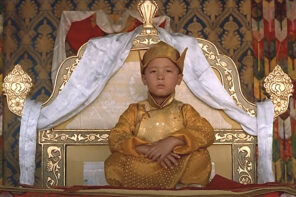This year has marked, I believe, the beginning of the end of the war between science and religion. Creationism cannot last. The New Atheists are now getting old. And between these camps the middle ground continues to expand.
Indeed, many folks have been hard at it, doing a new kind of peace work. Some have done it intentionally, some have not. Outliers, both atheist and religious hardliners, continue to wage battle but they look increasingly irrelevant.
Here are ten who, in small ways and large, have helped to spread seeds of peace on the blasted-out battleground of science and religion.
10. Karl Giberson, science & religion writer and former physicist, for reminding evangelicals that science is not the enemy
This has been a big year for Giberson. In February his book, The Language of Science & Faith, co-written by Francis Collins, was published; October saw the release of The Anointed: Evangelical Truth in a Secular Age, which Giberson penned with Randall Stephens. In both books Giberson comes forward as an evangelical Christian who embraces science.
It is in The Anointed that Giberson most forcefully carves out a uniquely evangelical space along the science-and-religion spectrum. This is a good thing, because in recent decades evangelical Christianity has found itself sidelined (due in large measure to its own mistakes) from a host of broader cultural and scientific conversations. Giberson writes,
The intellectual isolation of evangelicals has led to their near-universal rejection of evolution… a 2005 Pew Research Center survey revealed that almost two-thirds of evangelicals believed that ‘humans and other living things have existed in their present form only.’
Knowing that no expression of faith that rejects science can long survive, Giberson has cleared new science-friendly space for his co-religionists.
9. Jon Huntsman, US Ambassador to China, former Governor of Utah, candidate for the 2012 Republican nomination for president, for decoupling conservative politics and creationism
You know it’s bad when a candidate draws attention to himself for openly trusting scientists to do science.
But that’s the kind of year the GOP’s having. This year’s field of Republican presidential candidates has distinguished itself as possibly the least science-friendly in history. Rick Santorum’s over-the-top infatuation with creationism aside, Michele Bachmann has been especially vocal about her dislike of evolution. “I support intelligent design,” Bachmann told reporters earlier this year. “There is reasonable doubt on both sides.” As if this was not enough, in November she cried censorship (!) when asked if the teaching of intelligent design did not violate the First Amendment:
I think what you’re advocating for is censorship on the part of government… if you look at scientists there is not a unanimity of agreement on the origins of life… I think the best thing to do is to let all scientific facts on the table, and let students decide.
Rick Perry’s and Ron Paul’s views are not noticeably different, despite Paul’s non-retraction retraction of his opinion expressed in 2007.
In the midst of this, Jon Huntsman tweeted in response to one of Perry’s comments about evolution and climate change, “To be clear. I believe in evolution and trust scientists on global warming. Call me crazy.”
Huntsman is currently behind and looking to independents in New Hampshire to draw his name back into the light at that state’s Jan. 10 primary. One wonders if his August tweet has anything to do with his current prospects.
Whether or not it does, one thing is clear: his not-so-subtle suggestion that conservative politics is capable of standing apart from creationism is—if nothing else—refreshing.
Oh, Mitt Romney and Newt Gingrich get honorable mentions for not embarrassing themselves—on the evolution question, at least.
8. Jon Stewart, political satirist, for shining light on American Atheists’ frivolous lawsuit against the inclusion of the Ground Zero cross in the 9/11 memorial museum
In July American Atheists filed a lawsuit against those who planned to display a cross-shaped piece of wreckage at the 9/11 memorial.
In their statement, American Atheists said that the cross was a reminder to Christians “that their God, who couldn’t be bothered to stop the Muslim terrorists or prevent 3,000 people from being killed in his name, cared only enough to bestow upon us some rubble that resembles a cross.”
Predictably, FOX News had a field day. Glenn Beck called the lawsuit “hateful.” Mike Huckabee mixed it up with American Atheists president David Silverman. And no one in the center cared, because that’s what supposed to happen. The missiles flew overhead. We yawned tremendously.
Then, into this scene stepped a most unlikely player: Jon Stewart. In a hilarious three-minute clip, Stewart made the lawsuit look exactly as silly as it is and pointed out its hurtfulness to the cause of… atheists. Mimicking Silverman, Stewart declared that, “As president of the American Atheist organization, I promise to make sure that everyone, even those who were indifferent to our cause, will f—-ing hate us.”
Like it or not, Stewart’s opinion matters. I suspect his three-minute jab did more to moderate the discussion and alienate the outliers than anything Beck or Huckabee could ever dream up.
7. Nidhal Guessoum, astrophysicist, for reminding us that, in the minds of nearly 1.6 billion people, “science and religion” does not mean “science and Christianity”
The creationism-science debate is leaving American shores. It is being held in Arabic, not English, and focuses on the Qur’an, not the Bible.
As Islam has no central teaching authority, there is no easy way to gauge worldwide Muslim opinion of evolution and there are few hard data on Muslim views of evolution. Yet what data there are indicate that full acceptance of the theory is very low, somewhere between 10 and 20 percent. Salman Hameed, writing in Science, says, “Biological evolution is still a relatively new concept for a majority of Muslims, and a serious debate over its religious compatibility has not yet taken place.”
Guessoum, a professor at the American University of Sharjah, United Arab Emirates, is one of the few devout Muslims who are actively advocating the full-fledged acceptance of modern science. In January I.B. Tauris published his book, Islam’s Quantum Question: Reconciling Muslim Tradition and Modern Science. It has helped shape the debate in powerful ways. Hameed writes of the book,
There are very few good books out there that tackle the issue of Islam and science in a rational way. Often we find apologetic writings that grossly misunderstand science and end up doing a disservice to both Islam and science. Then we have books that address the issues of science and religion, but without a deeper understanding of religion. It is very rare (and I’m quite familiar with the terrain) where the writer takes both religion and science equally seriously. Nidhal’s book is in this rare category.
Thanks to Guessoum for charting new territory.
6. Jack Templeton, surgeon, president and chairman of the John Templeton Foundation, for bringing science into the church
You’d think science education would be easy and enjoyable: Look, kids! Isn’t the world amazing? Isn’t it wonderful?
But no. It’s been tough slog in 2011 to keep even good science curriculum in the classrooms of some states. But textbooks are a tiny problem compared to getting science teachers to teach science.
According to a study published by Science in January, only 28% of all biology teachers consistently teach evolution, 13% consistently teach creationism (intelligent design), and 60% waffle around in the middle somewhere, consistently failing to present evolution as the established scientific theory it is. Among the 60% are those who “teach the controversy,” fooling kids into thinking that what is not science, is science; that science and opinion are interchangeable; and that there is scientific disagreement about evolution, when in fact there is none.
Where does all of this start?
I’ll tell you: in American churches. Many churches are responsible for perpetuating the lie that evolution is scientifically controversial; many are responsible for painting science as intrinsically godless; many actively work against science education. But many more sit by in silence, not asking questions about evolution, thinking it doesn’t matter or being afraid of the answers.
Here’s the good news: earlier this year, the John Templeton Foundation put nearly one million of its dollars into local churches, with the goal of empowering parishioners—mostly science professionals—who have personally reconciled the claims of science and their religious commitments.
These churchgoers will be leading classes on evolution in their churches, advising church staff on how to incorporate science into curriculum at all levels of instruction, holding forums in churches on a range of scientific topics, and generally bringing the excitement of modern science to congregations everywhere.
5. Chris Stedman, interfaith activist and super-swell atheist guy, for decoupling atheism from science, and for being the face of a kinder, gentler atheism
This year saw the softening of the atheist universe. Perhaps the Four Horsemen came out hard because they had to, but in their wake have emerged atheists who are more interested in dialogue and shared values than in pounding the snot out of other people’s notions of God.
Don’t get me wrong; Stedman is the real atheist deal. He’s just not throwing grenades. In a May HuffPo piece he told the story of a Christian who challenged his atheism, saying, “OK, but tell me this, Mr. Atheist: Where did we come from? How did all of this get here?”
Stedman writes, “I answered: ‘Well, I’m not a scientist, but to be honest, that question doesn’t matter all that much to me. I’m not especially interested in how we got here; what concerns me, given that we are here, is what will we do?’”
It is a real step forward to have a public atheist who treats atheism as a perfectly plausible philosophy that does not obsessively look to science to prop it up. Of course he may, if you were to ask him, say that science told him there is no God. But he may not. We’ll have to wait for his memoir, (F)a(i)thiest, due out next year, to find out.
4. Rachel Held Evans, author, speaker, blogger, for making science and religion her thing, but not her main thing
Rachel Held Evans’ first book, Evolving in Monkey Town, came out in 2010. Her next, A Year of Biblical Womanhood, will see daylight in 2012. So this may seem an odd year to recognize Evans. But it’s not.
During 2010 she publicly engaged the likes of Albert Mohler and Ken Ham, insisting that her generation of evangelical Christians is turned off by the debate on which they are so fixated. In USA Today she is quoted to say, “My generation of evangelicals is ready to call a truce on the culture wars. It seems like our parents, our pastors, and the media won’t let us do that. We are ready to be done with the whole evolution-creation debate. We are ready to move on.”
Her full acceptance of evolution will not be lost on the thousands who read her upcoming book, and the next, and the next, whatever the books may be about. That she is taking a mature and battle-tested view of science into her evangelical future is a game-changer for science and religion dialogue in America.
3. All Those People Who Are Not Backing the Ark Park, for keeping the sure-to-be-divisive Ark Encounter from its scheduled August groundbreaking
If they don’t build it, they won’t come.
A field of dreams sits waiting in Grant County, Kentucky, not far from Cincinnati and less than an hour’s drive from Answers in Genesis’ Creation Museum. The dream? Ark Encounter, a “one-of-a-kind historically themed attraction, centered on a full-size, all-wood Ark, which should become the largest timber-frame structure in the USA.”
All year, I have been watching the fundraising thermometer at the Ark Park blog. It’s been moving really slowly. I wish I had recorded the data as the months rolled by, but it seems safe to say that, at current rates, it will take another five years to meet the $24.5 million goal set by the Ark Encounter masterminds (this is a small fraction of the project’s $150 million price tag). I suspect that’s not what they have in mind; they have publicized an opening date of 2014.
Is there a connection between the glacial fundraising rate and the groundbreaking that wasn’t? I suspect so, but perhaps not. I don’t have access to the financial details, and I know enough about fundraising to know that these things aren’t always so simple.
But the fact remains: fundraising has not moved along at the hoped-for pace. Someone out there, lots of someones really, have opted out of supporting the park.
I thank them. Such a park would only harden the edges of science-and-religion debate, distract many from the depth of scripture, harm science education, and be the occasion for much heat and little light on the good discussion brewing out here in the middle.
Here’s hoping the lights never go on for the overwrought, divisive dream called Ark Encounter.
2. Tenzin Gyatso, the 14th Dalai Lama, for reminding us that being ethical does not depend on belief in a personal God—nor, particularly, on science
Long an advocate for the harmonious coexistence of science and religion, HH the Dalai Lama this year brought us Beyond Religion: Ethics for a Whole World. In it he calls for us to look to our shared inner values. They are “kindness, patience, tolerance, forgiveness, and generosity,” and they represent the greater part of ethics.
In contrast, the particularities of different religious traditions tend to divide: “Any religion-based answer to the problem of our neglect of inner values can never be universal, and so will be inadequate.” And science, “for all the benefits it has brought to our external world, has not yet provided scientific grounding for the development of the foundations of personal integrity.” He therefore looks beyond both religion and science for a secular ethics.
Although His Holiness has spent the overwhelming number of his years in a monk’s robe, it is the man’s great humility that allows him to see beyond his own tradition to the needs of the greater world. For he must know that all religious systems—his own included—are merely signs pointing beyond themselves.
1. Terrence Malick, filmmaker, for reminding us that art may be the most compelling way to reconcile science and religion
“Preachy,” they said. “Self-absorbed,” they said. “A gargantuan work of pretension,” they said. Overwrought, pompous, ponderous, and just plain too much.
But this was the minority opinion of Terrence Malick’s The Tree of Life, released in May.
“The only other film I’ve seen with this boldness of vision is Kubrick’s 2001: A Space Odyssey and it lacked Malick’s fierce evocation of human feeling,” they said. “The sheer beauty of this film is almost overwhelming, but as with other works of religiously minded art, its aesthetic glories are tethered to a humble and exalted purpose, which is to shine the light of the sacred on secular reality,” they said. “Shot with a poet’s eye, Malick’s film is a groundbreaker, a personal vision that dares to reach for the stars,” they said.
True to its title, The Tree of Life is explicit about its biblical roots. The opening quotation comes from Job: “Where were you when I laid the foundation of the earth? When the morning stars sang together, and all the sons of God shouted for joy?” The pastor in the film preaches on Job and the central couple, Mr. and Mrs. O’Brien (played by Brad Pitt and Jessica Chastain), lose a child. And, just as happened to old Job, Mrs. O’Brien is counseled by a well-meaning but insensitive woman who offers nothing but platitudes: “He’s in God’s hands now.” (Mrs. O’Brien’s response: “He always was.”)
Shortly after this scene, just as happened to Job, we are treated to expansive scenes of creation. But we get more than Job did. The biblical writer knew of the starry firmament and of the beasts of the land, sea, and air, but we 21st-century Jobs get more: cosmic evolution; the formation of the Milky Way and its spiral structure; the ignition of the Sun’s nuclear fire; the molten, churning mass that Earth once was. We also see the development of life at its most rudimentary, molecular level; the emergence of life from ocean to land; several dinosaurs; and eventually primate and human life.
All sincere efforts at answering big questions draw near to the abyss of silliness, and some critics expressed woe at the juxtaposition of late Cretaceous dinos and middle-class 1950s Waco. I’m good with it. Those dinosaurs were here, really here, in our world, for nearly two hundred million years.
It is indeed a strange and beautiful world. Malick, in his graceful and courageous film, reminds us that it is made stranger and more beautiful the more we open ourselves to it.
Both the closed-hearted scientism of atheist hardliners and the narrow creationism of religious fundamentalists kill our strange and beautiful world by flattening it beyond repair. They deny its depth and mystery. Malick, in joyous contrast, has shown us—through art and not through argument—just how wondrous and surprising it is to live life out here in the middle.




